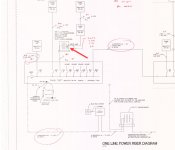solarken
NABCEP PVIP
- Location
- Hudson, OH, USA
- Occupation
- Solar Design and Installation Professional
I am finishing up an installation at a commercial site that has 3-phase 480V service, but with a 480 to 208Y120 transformer, so the PV system has 208Y120 Inverters. There is a 60A 3-pole disconnect for the system right near the transformer, and I connected the line side of the disconnect to the secondary lugs of the 480 to 208 transformer.
After I powered down the primary feed to the transformer and made the connections on the lugs, I did not see the neutral to ground bond inside the transformer that was shown on the single line dwg given to me by the customer. I have attached the single line to this post, with a red arrow showing the grounded neutral at the interconnection location. The PV disconnect is not shown on this dwg, but it is connected as I stated to the secondary lugs, with 6AWG copper line and neutral conductors and an 8AWG supply side bonding jumper to ground lug in the transformer.
I investigated while I had the power down, by measuring the resistance from secondary neutral lug to ground in the transformer with the two parallel neutral conductors that feed an existing 3-phase panelboard disconnected, and it was open, not grounded. With the neutrals from the panelboard connected, the measurement was 0.2 ohms. I opened the Eaton panelboard and did not see where/how the neutral was grounded but it must be grounded in that panelboard somewhere. GThe panelboard was pretty packed and I didn't have a lot of time.
My question is, do I need to adjust the bonding in the disconnect and install the neutral to ground bonding screw, given that the actual existing system appears to have the neutral to ground bonding jumper installed in a panelboard that is fed by the transformer rather than inside the transformer where I connected the PV system?

After I powered down the primary feed to the transformer and made the connections on the lugs, I did not see the neutral to ground bond inside the transformer that was shown on the single line dwg given to me by the customer. I have attached the single line to this post, with a red arrow showing the grounded neutral at the interconnection location. The PV disconnect is not shown on this dwg, but it is connected as I stated to the secondary lugs, with 6AWG copper line and neutral conductors and an 8AWG supply side bonding jumper to ground lug in the transformer.
I investigated while I had the power down, by measuring the resistance from secondary neutral lug to ground in the transformer with the two parallel neutral conductors that feed an existing 3-phase panelboard disconnected, and it was open, not grounded. With the neutrals from the panelboard connected, the measurement was 0.2 ohms. I opened the Eaton panelboard and did not see where/how the neutral was grounded but it must be grounded in that panelboard somewhere. GThe panelboard was pretty packed and I didn't have a lot of time.
My question is, do I need to adjust the bonding in the disconnect and install the neutral to ground bonding screw, given that the actual existing system appears to have the neutral to ground bonding jumper installed in a panelboard that is fed by the transformer rather than inside the transformer where I connected the PV system?


